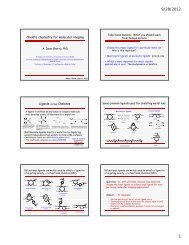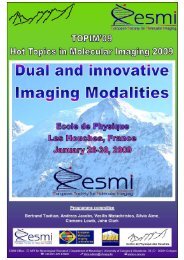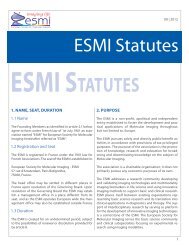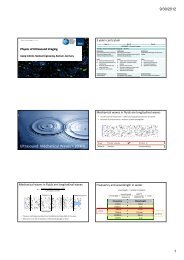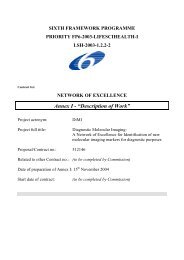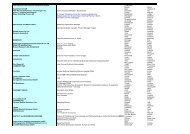5th EuropEan MolEcular IMagIng MEEtIng - ESMI
5th EuropEan MolEcular IMagIng MEEtIng - ESMI
5th EuropEan MolEcular IMagIng MEEtIng - ESMI
Create successful ePaper yourself
Turn your PDF publications into a flip-book with our unique Google optimized e-Paper software.
<strong>5th</strong> <strong>EuropEan</strong> <strong>MolEcular</strong> <strong>IMagIng</strong> <strong>MEEtIng</strong> – EMIM2010<br />
Assessment of HIF transcriptional activity in a mouse tumor model using GPI anchored avidin–<br />
a novel protein reporter for in vivo imaging<br />
Lehmann S. (1) , Garcia E. (2) , Blanc A. (2) , Schibli R. (2) , Keist R. (1) , Rudin M. (1) .<br />
(1) Animal imaging center,<br />
(2) Paul Scherrer Institute, Villigen, Switzerland.<br />
lehmann@biomed.ee.ethz.ch<br />
Introduction: With the emergence of multimodal<br />
imaging approaches genetic reporters, which can be<br />
flexibly combined with multiple imaging methods,<br />
are highly attractive. Here we present the feasibility<br />
of using glycosylphosphatidylinositol anchored avidin<br />
(av-GPI) (1) as a novel reporter for multimodal<br />
in vivo imaging. Expressed on the extracelluar side<br />
of cell membranes, av-GPI can be targeted with<br />
biotinylated imaging probes. In this study, we employed<br />
av-GPI to read out on the activity of hypoxia<br />
inducible factors (HIFs) in tumors. Induced by tumor<br />
hypoxia to mediate the adaptation of cells to<br />
low oxygen tensions these transcription factors play<br />
an important role in cancer progression. Typically,<br />
the expression of HIF in human cancer patients is<br />
associated with more aggressive tumor phenotypes<br />
and poor patient prognosis. Imaging HIF activity<br />
in live tumors hence provides an important tool to<br />
study the mechanisms leading to its activation in<br />
cancer.<br />
Methods: Mouse C51 cells were stably transfected<br />
with pH3SVG, a reporter construct driving the<br />
expression of avidin-GPI from a minimal SV40<br />
promoter and 3 hypoxia response element (HRE),<br />
bound by HIF, from the human transferrin gene<br />
(2). To monitor HIF activity in vivo, pH3SVG transfected<br />
C51 cells were subcutanouesly implanted into<br />
Balb/C nude mice. 10 days after tumor inoculation,<br />
mice received an i.v. injection of alexa-594-biocytin<br />
and were imaged using fluorescence reflectance<br />
imaging.<br />
Results: Fluorescence stainings of av-GPI expressing<br />
cells demonstrated that this protein is specifically expressed<br />
on the extracellular side of cell membranes.<br />
Moreover, upon pharmacological activation of HIF,<br />
we observed a shift in fluorescence indicative of<br />
an increased expression of av-GPI in fluorescent<br />
activated cell sorting (FACS) experiments involving<br />
pH3SVG transfected cells. In vivo fluorescence<br />
imaging showed a specific uptake of a biotinylated<br />
dye (alexa-594-biocytin) in the tumor from 60 minutes<br />
after contrast injection, whilst there was no<br />
accumulation of an unbiotinylated control probe<br />
(alexa-594-cadaverine). On ex vivo tissue sections<br />
alexa-594 biocytin was found to co-localize with<br />
zones positive for pimonidazole, a commonly used<br />
hypoxia marker (3) but also showed staining in regions<br />
devoid of pimonidazole uptake. In additional<br />
experiments, biotinylated 67Ga-DOTA was shown<br />
to specifically label avidin expressing cells in vitro.<br />
Conclusions: Overall, we demonstrate the utility<br />
of av-GPI as a reporter for in vivo imaging of HIF<br />
transcriptional activity in an optical, fluorescence<br />
reflectance approach. In vitro binding studies with<br />
67Ga-DOTA showed a high specificity of the probe<br />
in targeting av-GPI in cells, which implies that<br />
this reporter can indeed be combined with different<br />
imaging modalities. Its application in SPECT is<br />
currently being tested.<br />
References:<br />
1. Pinaud, F., King, D., Moore, H.-P. & Weiss, S. (2004)<br />
Bioactivation and Cell Targeting of Semiconductor<br />
CdSe/ZnS Nanocrystals with Phytochelatin-Related<br />
Peptides. Journal of the American Chemical Society<br />
126: 6115-6123<br />
2. Wanner, R. M., et al. (2000) Epolones induce<br />
erythropoietin expression via hypoxia-inducible<br />
factor-1 alpha activation. Blood 96: 1558-65<br />
3. Raleigh, J. A., et al. (1998) Hypoxia and vascular<br />
endothelial growth factor expression in human<br />
squamous cell carcinomas using pimonidazole as a<br />
hypoxia marker. Cancer Res 58: 3765-8<br />
<strong>EuropEan</strong> SocIEty for <strong>MolEcular</strong> <strong>IMagIng</strong> – <strong>ESMI</strong><br />
YIA applicant<br />
day1<br />
Plenary Session on Excellent and Late Breaking Abstracts



